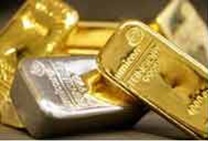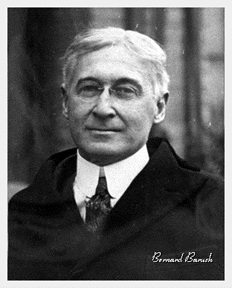What REALLY Controls The Metals Movement? (Part 3)
You may also enjoy Part 1 and Part 2 of this article.
 Why Sentiment Analysis Prevails Over Fundamental Analysis
Why Sentiment Analysis Prevails Over Fundamental Analysis
The common perception in the market is that the news causes changes in market psychology and fundamentals, which then causes changes in stock prices. But I believe that the correct, more consistently applicable premise is that market psychology and sentiment are the causes of news events and changes in stock prices, whereas fundamentals are purely lagging indicators, and the result of psychology and sentiment changes.
Bernard Baruch, an exceptionally successful American financier and stock market speculator who lived from 1870– 1965, identified the following long ago:
"All economic movements, by their very nature, are motivated by crowd psychology. Without due recognition of crowd-thinking ... our theories of economics leave much to be desired. ... It has always seemed to me that the periodic madness which afflicts mankind must reflect some deeply rooted trait in human nature — a trait akin to the force that motivates the migration of birds or the rush of lemmings to the sea ... It is a force wholly impalpable ... yet, knowledge of it is necessary to right judgments on passing events."

During his tenure as chairman of the Federal Reserve, Alan Greenspan testified many times before various committees of Congress. In front of the Joint Economic Committee, Green- span noted that markets are driven by “human psychology” and “waves of optimism and pessimism.” Ultimately, as Greenspan correctly recognized, it is social mood and sentiment that moves markets. I believe this makes much more sense when deriving the causality chain.
During a negative sentiment trend, the stock market declines, and the news seems to get worse and worse. Once the negative sentiment has run its course, however, and it’s time for sentiment to change direction, the general public then becomes subconsciously more positive.
When people become positive about their future, they are willing to take risks. What is the most immediate way that the public can act on this return to positive sentiment? The easiest is to buy stocks. For this reason, we see the stock market lead in the opposite direction before the economy and fundamentals have turned. This is why R.N. Elliott, whose work led to Elliott wave theory, believed that the stock market is the best barometer of public sentiment.
Let’s look at the same change in positive sentiment and what it takes to have an effect on the fundamentals. When the general public’s sentiment turns positive, this is the point at which they are willing to take more risks based on their positive feelings about the future. Whereas investors immediately place money to work in the stock market, having an immediate effect upon stock prices, business owners and entrepreneurs seek loans to build or expand a business, which take time to secure. They then place the newly acquired funds to work in their business by hiring more people or buying additional equipment, and this takes more time. With this new capacity, they are then able to provide more goods and services to the public, and, ultimately, profits and earnings begin to grow — after more time has passed.
When the news of such improved earnings finally hits the market, most market participants seem shocked that the stock starts to move up strongly (even though the stock likely bottomed well before the public takes notice when the investors effectuated their positive sentiment by buying stock), and they simply attribute the stock’s rise to the announcement of positive earnings.
There is a significant lag between a positive turn in public sentiment and the resulting change in the fundamentals of a stock or the economy, especially relative to the more immediate stock-buying activity that comes from the sentiment change. This is why fundamentalists can be left holding the bag at the top of a market, when the news and fundamentals look the most attractive, right before the market begins to dive, as sentiment turns in the opposite direction well before the fundamentals.
This lag is a much more plausible reason as to why the stock market is a leading indicator, as opposed to some form of investor omniscience. This also provides a plausible reason as to why earnings lag stock prices, as earnings are the last segment in the chain of positive mood effects on a business growth cycle. It is also why those analysts who attempt to predict stock prices based on earnings fail so miserably. By the time earnings are affected by a change in social mood, the social mood trend has already been negative for some time. And this is why economists fail as well — the social mood has shifted well before they see evidence of it in their “indicators.”
Lastly, we really have to begin to question whether exogenous events actually move markets. Don’t you ever question why markets go up after seemingly bad news or go down after seemingly good news?
Social experiments have actually been conducted which resulted in price patterns that mirror those found in the stock market. In 1997, the Europhysics Letters published a study conducted by Caldarelli, Marsili and Zhang, in which subjects simulated trading currencies, however, there were no exogenous factors that were involved in potentially affecting the trading pattern. Their specific goal was to observe financial market psychology “in the absence of external factors.”
One of the noted findings was that the trading behavior of the participants were “very similar to that observed in the real economy,“ wherein the price distributions were based on Phi (.618).
Their ultimate conclusion would surprise the most avid trader today:
In spite of the simplicity of our model and of the strategies of the single participants, and the outright exclusion of economic external factors, we find a market which behaves surprisingly realistically. These results suggest that a stock market can be considered as a self-organized critical system: The system reaches dynamically an equilibrium state characterized by fluctuations of any size, without the need of any parameter fine tuning or external driving.
Marsili was quoted as saying that “the understanding that we got is that the statistics of price histories in financial markets can be understood as the result of internal interaction and not the fundamental interaction with the external world.”
In August 1998, the Atlanta Journal-Constitution published an article by Tom Walker, who conducted his own study of 42 years’ worth of “surprise” news events and the stock market’s corresponding reactions. His conclusion, which will be surprising to most, was that it was exceptionally difficult to identify a connection between market trading and dramatic surprise news. Based upon Walker's study and conclusions, even if you had the news beforehand, you would still not be able to determine the direction of the market only based upon such news.
Robert Prechter Jr., in his book The Wave Principle of Human Social Behavior, in which he cites many of these instances, concludes:
“once you realize that even if you got [the news] in advance, you could not forecast the stock market. Though these facts are counter-intuitive, it does not take a dedicated market student long to observe the acausality of news to the stock market.”
R.N. Elliott, in his 1946 publication of Nature’s Law, probably puts it best when he said:
“At best, news is the tardy recognition of forces that have already been at work for some time and is startling only to those unaware of the trend.”
So, then what actually drives market movement?
As we mentioned before, Mr. Greenspan noted that markets are driven by “human psychology” and “waves of optimism and pessimism.” Ultimately, as Mr. Greenspan correctly recognized, it is social mood that will move markets. This is why news does not cause a change in the trend of the market, unless that trend is already set to change. In fact, have you ever wondered why a market will continue to go up after the announcement of bad news, or down after the announcement of good news?
This is why any investor who is able to rise above news and emotion, and identify the prevailing social moods and trends, will have a significant advantage over other investor.
Ralph Nelson Elliott postulated that public sentiment and mass psychology moves in 5 waves within a primary trend, and 3 waves in a counter-trend. Once a 5 wave move in public sentiment is completed, then it is time for the subconscious sentiment of the public to shift in the opposite direction, which is simply a natural cause of events in the human psyche, and not the operative effect from some form of “news.”

This mass form of progression and regression seems to be hard wired deep within the psyche all living creatures. This is what we have come to know today as the “herding principle,” and the herd seems to turn at Fibonacci ratios, as supported by the studies mentioned before.
Humans are hard wired for herding within their basal ganglia and limbic system within their brain, which is a biological response they share with all animals. In fact, in a study performed by Dr. Joseph Ledoux, a psychologist at the Center for Neural Science at NYU, he noted that emotion and the reaction caused by such emotion occur independent and prior to, the ability of the brain to reason.
In a paper entitled “Large Financial Crashes,” published in 1997 in Physica A., a publication of the European Physical Society, the authors, within their conclusions, present a nice summation for the overall herding phenomena within financial markets:
Stock markets are fascinating structures with analogies to what is arguably the most complex dynamical system found in natural sciences, i.e., the human mind. Instead of the usual interpretation of the Efficient Market Hypothesis in which traders extract and incorporate consciously (by their action) all information contained in market prices, we propose that the market as a whole can exhibit an “emergent” behavior not shared by any of its constituents. In other words, we have in mind the process of the emergence of intelligent behavior at a macroscopic scale that individuals at the microscopic scales have no idea of. This process has been discussed in biology for instance in the animal populations such as ant colonies or in connection with the emergence of consciousness.
In fact, one commenter to one of my articles on Seeking Alpha made the following astute point regarding how news affects these subconscious herding trends:
Compare the market to a stream of ants marching by in, generally, a single direction. Run a stick across their path and there will be some momentary confusion and reaction to the direct stimuli but very soon afterwards the original parade of ants continues and the stimulus is forgotten.
So, based upon much research, it does seem that the market may be considered to be on a path that is determined by a mass form of herding that is given direction by social mood. It sure does explain the oft asked question of why markets go up when bad news is announced or vice versa. I also explains why metals dropped strongly even though QE-infinity was put into action. And, it also takes out all the guess work in attempting to determine the next “news event” that may move markets.
********
Courtesy of ElliottWaveTrader.net






 Avi Gilburt is a widely followed Elliott Wave technical analyst and author of
Avi Gilburt is a widely followed Elliott Wave technical analyst and author of 









